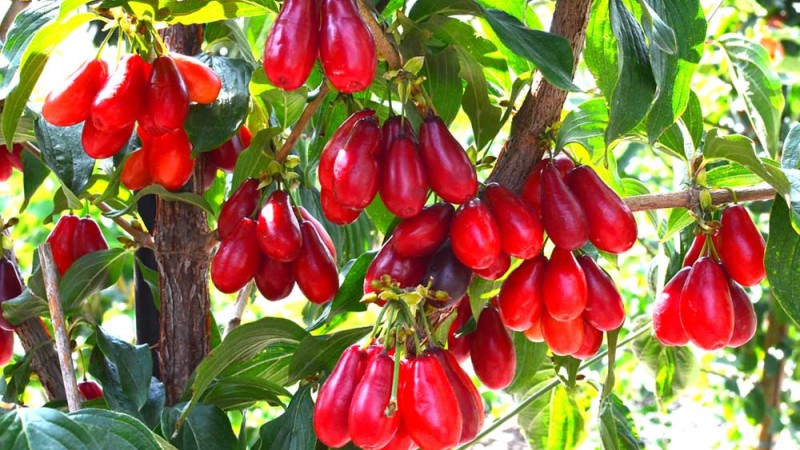
Drieň obyčajný (Cornus mas L.) z čeľade drieňovitých (Cornaceae) je netradičný ovocný druh produkujúci veľmi cenné, nutrične bohaté a zdraviu prospešné a ovocie. Pochádza zo strednej a južnej Európy, Malej Ázie a Kaukazu. Drieň prirodzene rastie v lesostepiach, suchých a presvetlených lesoch a na skalnatých stráňach. Je veľmi nenáročný, prispôsobivý, mrazuvzdorný a dožíva sa vysokého veku.
Zatiaľ čo komerčné plantáže drieňa sú relatívne vzácne, amatérske výsadby existujú v rôznych európskych krajinách a spontánne populácie prosperujú v regiónoch ako Irán, Azerbajdžan a Turecko. V poslednej dobe si tento druh získava čoraz väčšiu pozornosť. Viaceré veľkoplodé odrody sú zaujímavým obohatením záhrad. Ich chutné plody sú vhodné na priamu konzumáciu aj na spracovanie a početné žlté kvety sú zároveň veľmi dekoratívne a lákavé pre včely.
Drieň obyčajný je ker alebo menší strom s nízkym kmeňom dorastajúci do výšky 3 metre. Čím staršia je rastlina, tým viac spomaľuje svoj rast. Drieň je dlhoveký strom, ktorý pri dobrej starostlivosti prináša úrodu aj po niekoľko generácií. Vďaka mrazuvzdornosti dokáže rásť v podhorských oblastiach až do nadmorskej výšky 1000 metrov aj viac. Jeho žlté kvety sú samoopelivé a objavujú sa v hojnom počte v marci a apríli. Avšak pre vyššiu úrodu je výhodou prítomnosť ďalšej rastliny.
Plody majú najčastejšie hruškovitý tvar. Typickou farbou plodov je sýtočervená, prípadne tmavočervená, hoci poznáme aj žlté odrody drieňa. Plody dozrievajú koncom augusta a úrodu zbierame až do októbra. Nedozreté plody sú trpké. Po úplnom dozretí sú aromatické a sladko-kyslé. Intenzita vône a chuti je závislá od odrody. Konzumácia čerstvých plodov je zdraviu najprospešnejšia. Je ich však možné spracovať v kompótoch, kandizovať, sterilizovať, poslúžia na výrobu džemov, štiav, sirupov a slúžia tiež na výrobu ovocných destilátov.
Požiadavky na pestovateľské podmienky
Drieň nie je náročný na pôdu. Darí sa mu však predovšetkým v zásaditých, dobre priepustných pôdach, horšie znáša kyslé a chudobné pôdy. Kyslú pôdu je však možné upraviť pridaním dolomitu, alebo vápenca. Hoci je drieň rastlina odolná voči suchu, miluje mierne vlhké pôdy. Drieň sa cíti najlepšie v polotieni. Rastliny prakticky nie sú poškodzované škodcami a chorobami. Nevyžadujú ošetrenie pesticídmi ani žiadne špeciálne agrotechniky.
Výsadba a starostlivosť
Najideálnejší čas na výsadbu je jeseň. Kontajnerovú rastlinu je možné sadiť od jari do jesene. Ak je rastlina štepená na podpník, miesto štepenia musí zostať po výsadbe nad zemou. Jednotlivé rastliny na úrodných pôdach od seba sadíme na vzdialenosť 3-4 metre, na chudobnejších pôdach a bez zavlažovania na 2-3 metre, pričom sa berie do úvahy, že driene sa dožívajú 100-150 rokov a po celý čas pri správnej starostlivosti bohato plodia. Výsadbová jama by mala mať hĺbku 40-50 cm a šírku 50-80 cm v závislosti od veľkosti sadenice. Jama sa vyplní zmesou kompostu, vrchnej vrstvy pôdy a vápenca, ak je pôda kyslá.
Po výsadbe je dôležité sadenicu výdatne zaliať a výhony skrátiť o 1/2-1/3, aby sa vyvážil nadzemný a koreňový systém. Keďže koreňový systém drieňov je pomerne plytký, je dobré pôdu v letných mesiacoch zalievať, aby sa koreňom zabezpečil dostatok kyslíka a vody. Príliš suchá pôda môže ovplyvniť kvalitu úrody v danom roku, ale aj v nasledujúcom. Korene sa môžu poškodiť aj prehriatím na slnku. Preto je dobrým opatrením použitie mulčovacej kôry, drevenej štiepky alebo kombinácie geotextílie a mulču.
Pre driene je vhodný univerzálny systém hnojenia. Viaczložkovým minerálnym hnojivom hnojíme počas vegetačného obdobia a na jeseň do pôdy zapracujeme organické hnojivo ako je kompost, alebo maštaľný hnoj. Vysychanie listov môže byť spôsobené nedostatkom draslíka. Tomu sa dá predísť vhodným hnojivom. Pozor však na prehnojenie. Štepené rastliny začínajú prinášať plody v 2. – 3. roku, zatiaľ čo semenáče až v 5. – 7. roku po výsadbe. Mladý drieň poskytne úrodu asi 15 kg plodov, vekom sa produkcia za priaznivých pestovateľských podmienok zvyšuje a môže dosiahnuť až 80 kg plodov na jednu rastlinu.










